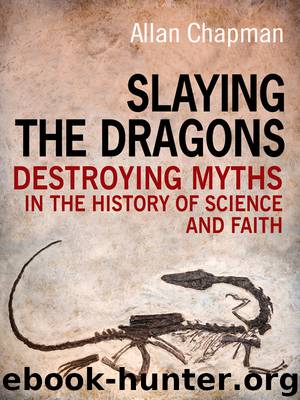Slaying the Dragons by Allan Chapman

Author:Allan Chapman
Language: eng
Format: epub
Publisher: Lion Hudson
Published: 2013-11-15T05:00:00+00:00
The Origins of Life: Pre-Darwinian Ideas of “Evolution”
We saw in the previous section how the idea of an ancient earth was firmly established among most of the formally- and the self-educated classes long before 1859. Yet the development of naturalistic geology from the seventeenth century to the Victorian age had not fundamentally challenged the biblical idea of the uniqueness of the human race; rather, humanity was seen as the crowning glory in an ancient planet.
On the other hand, it is false to assume that before Charles Darwin no one had seriously considered evolution – or, under its older name, “transmutationism”. Quite the contrary, in fact: by the time Darwin published Origin in 1859, naturalistic species-change ideas had been discussed for almost two centuries. Indeed, on page 291 of his 1668 “Earthquake Discourse”, Robert Hooke not only speaks of extinction but says “that ’tis not unlikely also but that there may be divers new kinds [of living creatures] now, which have not been from the beginning”. An opinion he repeats in other places. And let us not forget that these “Discourses” were first delivered to Royal Society meetings with clerical FRSs in his audience. Of course, Hooke was not proposing any biological mechanism for this change – just noting the stratigraphic appearance of new forms, whether divinely or naturally created. Yet as he makes clear elsewhere in his “Discourses”, every classically educated gentleman was familiar with the notion of species change from Greek mythology, though that, admittedly, was not the same thing as science.
I would, however, be cautious about reading too much evolution into Hooke’s remarks on fossils and species change. For Hooke was a physicist by instinct, not a natural historian, and was primarily interested in the physics of earth-forming processes, and not so much in living creatures themselves.
All of these ideas and speculations about geology, fossils, and species, moreover, would have been readily available to John and Charles Wesley when they were undergraduates at Oxford. For Hooke, let us remember, like the Wesleys, had been a Christ Church man, and a copy of his Posthumous Works (1705), containing the “Earthquake Discourses”, has been in the Christ Church library for nearly 300 years (yes, I have checked) – not to mention copies in the Bodleian and other Oxford libraries!
Yet let us not lose sight of the fact, as noted in Chapter 2, that comparative anatomists had been aware since classical times that human and higher-animal bodies shared an enormous number of structural and functional features. Indeed, the Scottish nobleman Lord Monboddo, whom Dr Samuel Johnson encountered when visiting Scotland in 1773, was well known for his opinion that humans were related to monkeys, and there seems to have been jokes doing the rounds about men with tails. But the overwhelming weight of scientific opinion in the eighteenth century, geological timescales apart, was that species were fixed. And that view, on its highest authority, derived not from the Bible, but from scientific botany and natural history. For the great Swedish botanist
Download
This site does not store any files on its server. We only index and link to content provided by other sites. Please contact the content providers to delete copyright contents if any and email us, we'll remove relevant links or contents immediately.
The Gnostic Gospels by Pagels Elaine(2472)
Jesus by Paul Johnson(2310)
Devil, The by Almond Philip C(2282)
The Nativity by Geza Vermes(2180)
The Psychedelic Gospels: The Secret History of Hallucinogens in Christianity by Jerry B. Brown(2121)
Forensics by Val McDermid(2044)
Going Clear: Scientology, Hollywood, and the Prison of Belief by Lawrence Wright(1938)
Going Clear by Lawrence Wright(1923)
Barking to the Choir by Gregory Boyle(1786)
Old Testament History by John H. Sailhamer(1768)
Augustine: Conversions to Confessions by Robin Lane Fox(1736)
The Early Centuries - Byzantium 01 by John Julius Norwich(1700)
A History of the Franks by Gregory of Tours(1684)
A Prophet with Honor by William C. Martin(1682)
Dark Mysteries of the Vatican by H. Paul Jeffers(1675)
The Bible Doesn't Say That by Dr. Joel M. Hoffman(1652)
by Christianity & Islam(1594)
The First Crusade by Thomas Asbridge(1576)
The Amish by Steven M. Nolt(1530)
